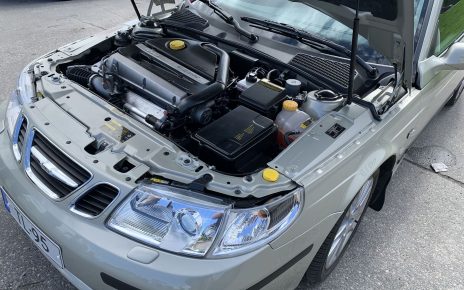The Saab 9-5 was launched as a replacement to the Saab 9000 in 1998. With its introduction it became the biggest car produced by Saab. A total of 483,593 9-5’s were produced in two distinctly different versions and both generations from 1998 to 2012.
Saab 9-5 First Generation
Designed by a team led by Einar J. Hareide the first generation of the Saab 9-5 was launched in 1998 as a successor to the Saab 9000, with the estate version launched the following year. The engines and gearboxes were further developments on what was used as in the Saab 9000. The chassis on the Saab 9-5 was equipped with a unique split rear axle, the first time this was used by Saab.
The Saab 9-5 interior offered a lot of unique features when launched, for example the “Night Panel” which allowed for all instruments except the speedometer to be switched off in the dark. Unlike the other cars, the ignition key sits between the front seats. The main reason for this is safety, since it removes the risk of the key being jammed into the knee or other parts of the body during a collision, which can happen if it’s in the dashboard or steering column. Compared to the Saab 9-3, the space and ride comfort were significantly better, although the size does not differ much externally.
MY 98-02

In 2002 the 9-5 was updated with a new range of engines. 2.2 Diesel engines were added to range, new updated engine breather system on Petrol engines added, a new front grille design, new tailgate and tail lights, new steering system and a new type of adaptive airbag. From 2002, ESP (electronic stability control) was included as standard.
MY 02-04

In 2004 9-5 got a facial restyle to specially stand out the Aero version. Most powerful and top of the range 9-5. It got so-called Sharktooth front bumper and some small technical additions as uprated chassis components and mountings.
MY 04

Major updates in 2006 happened with 9-5. Among the redesigned exterior (for example new front and full red tail lights), new instrumentation, harder shock absorbers, increased track width by 6 mm, and an increased length of 9 mm for the saloon model and 13 mm for the estate, new, more powerful 1.9 diesel engine was introduced, as well as the top of the range Aero model, was given more power from 250 bhp to 260 bhp and was fitted with wider tires. In fact the Aero has been praised by journalists around the world on numerous occasions.
MY 06-10

Saab 9-5 Second Generation
A brand new Saab 9-5 was introduced for the 2010 model year. This new 9-5 came with a wide range of petrol, BioPower and diesel engines to meet local requirements. It was available with both a manual and automatic 6-speed gearbox.
Counting all versions of the new Saab 9-5 there were two four-cylinder engines offered for petrol and diesel respectively, with a V6 engine also available for the petrol versions.
Some of the features of the second generation Saab 9-5 were:
ESP with 4-wheel ABS as standard, advanced XWD with eLSD as an option, the electronically controlled DriveSense real time shock absorption as an option, and the option to have the Head-up-display.
MY10-12

The Saab 9-5 introduced Saab’s Active Head Restraints (SAHR), which moved up and forward to prevent whiplash when the car was struck from the rear. This feature won technology and safety awards around the globe. The Saab 9-5 also was one of the first cars to have extensive side-crash protection.
Fast forward to present day, both generations of the Saab 9-5 still maintain a high level of safety. In fact, both generations have five stars, the highest grade, in EuroNCAP’s collision test.
The Saab 9-5, and especially the estate version, was a massive success and for many years one of the most sold cars in Sweden. In addition the Saab 9-5 has been ranked as the safest car in Sweden by one of the largest insurance providers, Folksam, on numerous occasions.





Comments on Saab 9-5 and why we love it